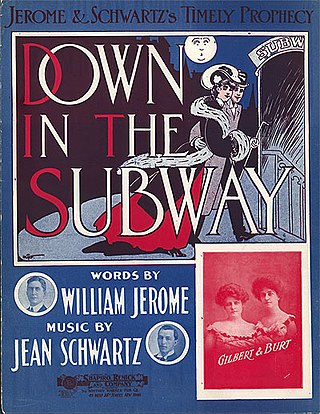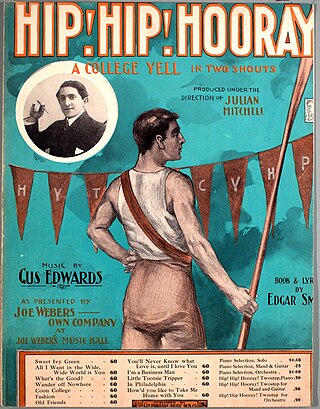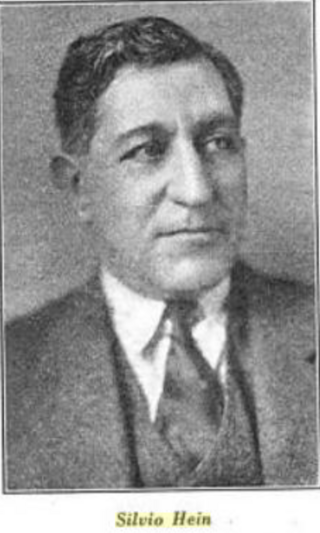Related Research Articles

Jean Schwartz was a Hungarian-born Jewish American composer and pianist. He is best known for his work writing the scores for more than 30 Broadway musicals, and for his creation of more than 1,000 popular songs with the lyricist William Jerome. Schwartz and Jerome also performed together on the vaudeville stage in the United States; sometimes in collaboration with Maude Nugent, Jerome's wife, and the Dolly Sisters. Schwartz was married to Jenny Dolly from 1913 to 1921.

William Jerome Flannery, September 30, 1865 – June 25, 1932) was an American songwriter, born in Cornwall-on-Hudson, New York, of Irish immigrant parents, Mary Donnellan and Patrick Flannery. He collaborated with numerous well-known composers and performers of the era but is best remembered for his decade-long association with Jean Schwartz with whom he created many popular songs and musical shows in the 1900s and early 1910s.

Louisiana Purchase is a musical with music and lyrics by Irving Berlin and book by Morrie Ryskind based on a story by B. G. DeSylva. Set in New Orleans, the musical lightly satirises Louisiana Governor Huey Long and his control over Louisiana politics. An honest U.S. senator travels to Louisiana to investigate corruption in the Louisiana Purchase Company; the company's lawyer attempts to divert him via the attentions of two beautiful women, but the senator maintains his integrity and ends up marrying one of them. In 1941 it was adapted for the film Louisiana Purchase directed by Irving Cummings.

"Chinatown, My Chinatown" is a popular song written by William Jerome (words) and Jean Schwartz (music) in 1906 and later interpolated into the musical Up and Down Broadway (1910). The song has been recorded by numerous artists and is considered an early jazz standard.

The Little Show was a musical revue with lyrics by Howard Dietz and music by Arthur Schwartz. It was the first of 11 musicals that featured the songs of Dietz and Schwartz. The revue opened at the Music Box Theatre on Broadway on April 30, 1929 and ran for 321 performances until February 1930.

The Band Wagon is a musical revue with book by George S. Kaufman and Howard Dietz, lyrics also by Dietz and music by Arthur Schwartz. It first played on Broadway in 1931, running for 260 performances. It introduced the song "Dancing in the Dark" and inspired two films.
Stanislaus Stange (1862–1917) was a playwright, librettist and lyricist who created many Broadway shows in the fin-de-siecle era and early 20th century. After minor success as an actor, Stange made his career as a writer in the musical theatre, moving towards more varied theatrical work before his death.

Parade is a musical revue with book, music, and lyrics by Jerry Herman.

Red, White and Maddox is a satirical musical revue written by Jay Broad and Don Tucker. The play debuted in Atlanta in October 1968 and later had a 41-performance run on Broadway from January 26 to March 1, 1969. The play was conceived by Broad, who at the time was the director of the Theatre Atlanta theatrical company. Modeled as a fictional biography of Georgia Governor Lester Maddox, the play is split into two acts. The first act chronicles Maddox's foray into politics as a firebrand segregationist, culminating in him becoming governor of the state. The second act, set in the future, details Maddox becoming president of the United States.
Ernest Albert, born Ernest Albert Brown, was an American painter, illustrator, muralist, and scenic designer. He was a prolific scenic designer, first in St. Louis and Chicago and then on Broadway. He is considered a major American landscape painter and was elected the first president of the Allied Artists of America in 1919.
The Billionaire is a musical in three acts with music by Gustave Kerker, and both book and lyrics by Harry B. Smith. The show was written with the backing of producers Klaw and Erlanger and was made specifically for the talents of Jerome Sykes who portrayed "The Billionaire", John Doe. The action of the musical begins in Nice, France during Carnival where the billionaire Sykes meets a young American girl, Pansy Good, studying to be an actress. Impressed with her talents, he buys her Doe's Theatre in New York City and establishes her as a star. Later, Doe attempts to ride a horse in a race at the Longchamp Racecourse in Paris, but is too fat to succeed. Pansy rides the horse instead and wins the race.
The Gingerbread Man is a musical in two acts with music by A. Baldwin Sloane and both book and lyrics by Frederic Ranken. Described by the creators as a "Fanciful Fairyesque", the work was essentially a Christmas musical with Santa Claus and Mrs. Claus serving as the heroes of the piece.

Hip! Hip! Hooray! is a musical in two acts with music by Gus Edwards and both lyrics and book by Edgar Smith.
Leona Stephens, also known as Leona Hollister, Leona Stephens Hollister, Leona Hollister West, and Leona Stephens Hollister West, was an American actress, vaudeville performer, playwright, and songwriter who had an active career on stage and radio during the first half of the 20th century.
Piff! Paff!! Pouf!!! is a musical in two acts with music by Jean Schwartz, lyrics by William Jerome, and a book by Stanislaus Stange. It is considered the best musical created by the writing team of Schwartz and Jerome. A hit with audiences, it was the longest running musical of the 1903-1904 Broadway season. Set on the Atlantic City Boardwalk and at a mansion along the banks of the Hudson River in the Hudson River Valley in the state of New York, the musical follows a recently widowed man whose deceased wife, an heiress, left him her fortune in her will on the condition that he marry off all four of their daughters in the order of their birth prior to receiving any of her money.

Silvio Hein was an American composer, songwriter, conductor, and theatrical producer. He was a songwriter for Tin Pan Alley and composed the scores to fourteen Broadway musicals. His most successful stage work was the 1917 musical Flo-Flo which he created with the French librettist and playwright Fred de Gresac. His songs were also interpolated into musicals created by others, including The Little Duchess and Ziegfeld Follies. In addition to his work writing music, he also worked as both a conductor and producer on Broadway. In 1914 he was a founding member of the American Society of Composers, Authors and Publishers.
Owen Murphy was an American songwriter, film maker, and writer for radio, film, and theatre. He worked as a lyricist, composer, and playwright for Broadway musicals and as a songwriter for Tin Pan Alley in the 1920s and 1930s. As a film maker he was an early maker of industrial films. He also was a writer for comedian Joe Cook for both the stage and radio.

Albert Gumble was an American composer, pianist, music arranger, and songwriter. After graduating from the Auditorium School of Music in Cincinnati, he lived and worked briefly in Chicago during the early years of the twentieth century before moving to New York City where he worked as a Tin Pan Alley composer of ragtime pieces and songs. As a songwriter he was particularly associated with dixie tunes. He also was a prolific music arranger and contributed music to several Broadway musicals. From 1938 until his death in 1946 he was a resident pianist at the Ansonia Hotel.
References
Citations
- ↑ Fields, p. 182
- ↑ Bordman & Norton, p. 303
- ↑ Dietz, p. 28-29
- ↑ Suskin, p. 39
- ↑ Dietz, p. 27
- ↑ Lasser, p. 1840
- ↑ Garrett, p. 246
- ↑ That Beautiful Rag - Arthur Collins (Columbia A853) (1910) . Retrieved 2024-05-02– via www.youtube.com.
- ↑ That Beautiful Rag by Collins & Harlan (Nov. 1910) . Retrieved 2024-05-02– via www.youtube.com.
- ↑ That Beautiful Rag (Stella Mayhew and Billie Taylor) . Retrieved 2024-05-02– via www.youtube.com.
Bibliography
- Bloom, Ken (2013). Routledge Guide to Broadway. Taylor & Francis. ISBN 9781135871161.
- Bordman, Gerald Martin; Norton, Richard (2010). "Up and Down Broadway". American Musical Theatre: A Chronicle. Oxford University Press. ISBN 9780199729708.
- Dietz, Dan (2021). "Up and Down Broadway". The Complete Book of 1910s Broadway Musicals. Rowman & Littlefield Publishers. ISBN 9781538150283.
- Fields, Armond (2009). Eddie Foy: A Biography of the Early Popular Stage Comedian. McFarland & Company. ISBN 9780786443284.
- Garrett, Charles Hiroshi (2008). Struggling to Define a Nation: American Music and the Twentieth Century. University of California Press. ISBN 9780520254879.
- Lasser, Michael (2014). America's Songs II: Songs from the 1890s to the Post-War Years. Taylor & Francis. ISBN 9780415810074.
- Suskin, Steven (2010). "Up and Down Broadway". Show Tunes: The Songs, Shows, and Careers of Broadway's Major Composers. Oxford University Press, USA. ISBN 9780195314076.